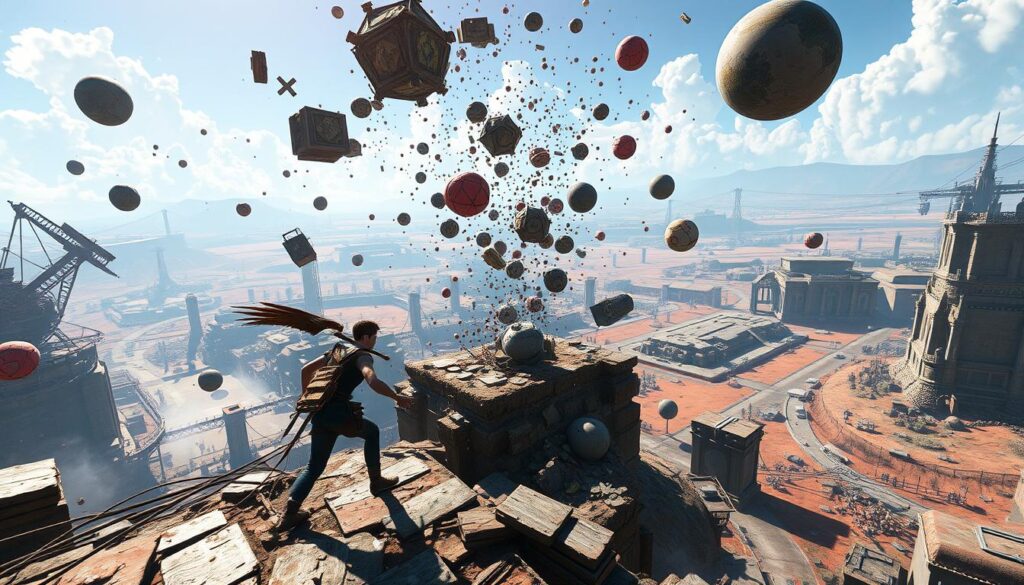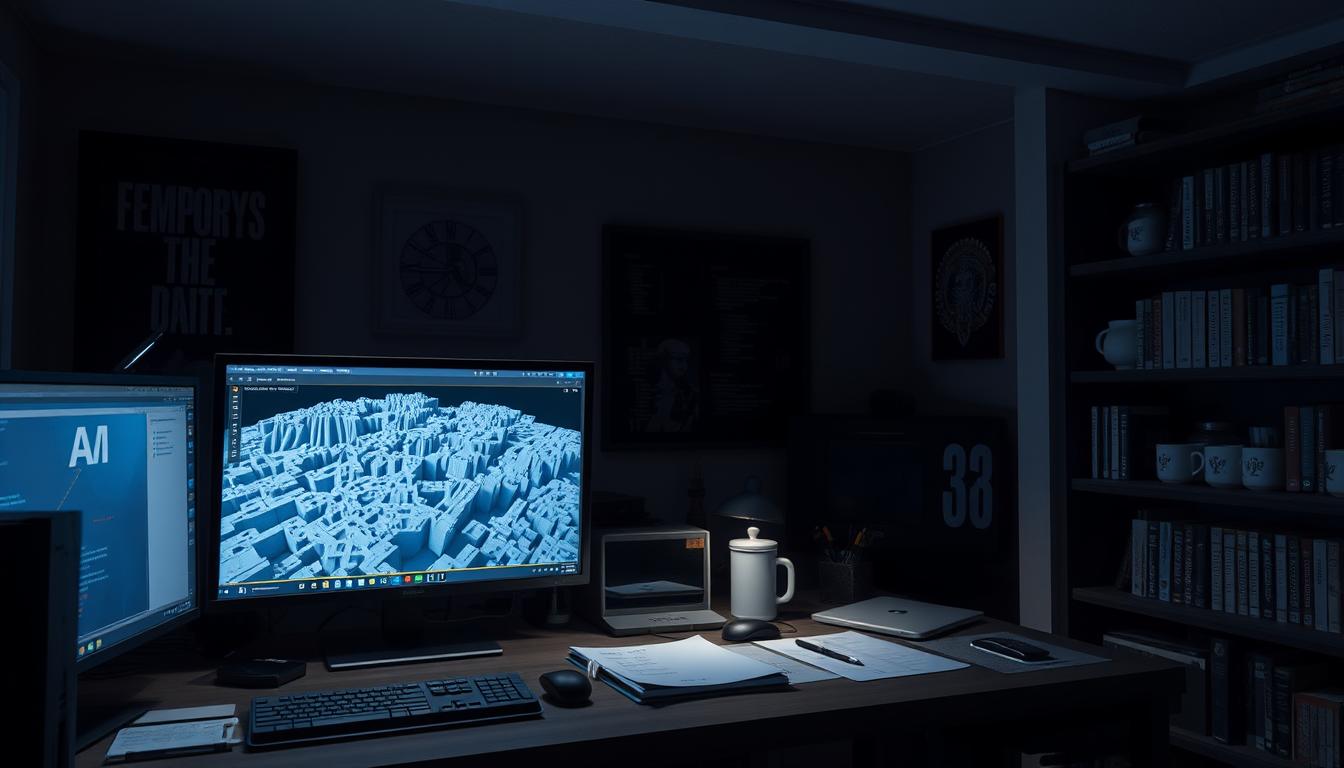Imagine if the game worlds designed to pull you in could actually ruin your experience. In game development, collision bugs in dynamic procedural maps are a big problem. These bugs can mess up gameplay and make the adventure less fun. This article will show you how to avoid these bugs, focusing on dynamic procedural generation and efficient collision detection.
By using these strategies, developers can make their games better. This ensures players have a smooth and enjoyable experience while exploring.
Understanding Dynamic Procedural Generation
Dynamic procedural generation uses complex algorithms to create detailed game worlds and assets. This method cuts down on the need for manual design work. It also makes games more unique and varied, which players love.
Setting up the right parameters is key for success. Tools like Perlin noise help make terrain look real and smooth. Knowing these basics is important for understanding procedural generation’s role in game development.

Benefits of Collision Detection in Game Development
Collision Detection is key in game development. It makes sure virtual objects act like they really do in the game world. This makes the game feel more real and fun to play.
It also stops problems like objects getting stuck together. This can ruin the fun and make players get frustrated.
Another big plus is how it makes the game world feel real. With good collision detection, players feel like they’re really there. It’s like stepping into a new world.
Also, it helps make the game run smoothly. It stops the game from slowing down when lots of things are happening at once. This means players can enjoy the game without any hiccups.
In short, using good collision detection makes games better. It makes players happy and the game more enjoyable.

Key Algorithms for Procedural Content Generation
In game development, Procedural Content Algorithms are key. They make games more immersive by creating diverse worlds. For example, Perlin noise makes terrain look real, and cellular automata create detailed patterns.
Voronoi diagrams help organize game spaces, making them feel natural. Each algorithm has its own role in game design. By using these efficient algorithms, developers can make games better.
Reports show that using these algorithms well boosts game performance. It’s crucial for developers to learn and use the best ones. This can make games more innovative and fun.
| Algorithm | Application | Benefits |
|---|---|---|
| Perlin Noise | Terrain generation | Natural-looking surfaces |
| Cellular Automata | Pattern creation | Complex structures and designs |
| Voronoi Diagrams | Spatial partitioning | Efficient organization of game elements |
Designing Diverse Environments with Procedural Tools
Video game environments have changed a lot with procedural tools. These tools help developers make diverse and exciting landscapes. They use modular assets to create many different worlds, making the game development process better.
Procedural tools make it easy to create and customize environments. This means each game world is unique, tailored to the player’s experience. Designers can add special details, like where trees are placed or the terrain layout, using these tools.
Using procedural tools makes designing environments faster and more appealing. This approach boosts player engagement and satisfaction. It helps games stand out in a crowded market, offering a memorable experience.
Importance of Efficient Collision Geometry
Efficient collision geometry is key for a great user experience in dynamic maps. A good collision detection system cuts down on bugs that mess up gameplay. Developers should aim to make collision shapes that look like the game’s visuals but are also fast to process.
Using simpler shapes can make the game run better, making it smoother. In game physics, accurate collision geometry saves time and boosts performance. Following best practices in this area helps avoid crashes and improves the game.
Reports show that bad or too complex collision geometry can ruin a game. It leads to player frustration and bad reviews. By focusing on efficient design, developers make the game better and more stable. This keeps players engaged without the problems caused by collision issues.
Utilizing Noise Functions for Realistic Terrain
Noise functions, like Perlin noise, are key in making game terrains look real. They create natural patterns that make the game feel more immersive. By using different layers of noise, developers can make landscapes with hills, valleys, and plains.
Noise functions are very flexible. They can mix different terrain features smoothly. For instance, mixing Perlin noise with other algorithms can make unique landscapes. This makes the game world more diverse and exciting to explore.
Using noise functions makes games more fun and rewarding. The landscapes they create feel adventurous and full of surprises. So, using noise functions is a must for developers who want to make their game worlds more realistic and engaging.
Avoiding Collision Bugs in Dynamic Procedural Maps
Creating dynamic maps is a big challenge, especially with collision bugs. These bugs can mess up the game. To fix this, teams need to be proactive about finding and fixing these issues.
They should use the right shapes for collisions and test different methods. This makes sure that objects in the game work together smoothly.
Implementing Effective Collision Shapes
Shapes are key in where and how objects interact. It’s important to design these shapes well to avoid bugs. Developers should make sure the collision shapes match what players see.
This keeps the game looking and feeling right. It helps players stay in the game world.
Testing Various Collision Methods
Testing different ways for objects to collide is tough. But it’s crucial. Techniques like rigid body dynamics and continuous collision detection are good choices.
By testing these methods, developers can find problems early. This makes the game better and keeps players happy by fixing annoying bugs.
Common Pitfalls in Procedural Map Design
Procedural map design comes with many challenges. These can lead to big game design issues if not handled right. Developers often face procedural map pitfalls like overly complex algorithms. This can slow down the game and make it less fun for players.
Not enough randomness can also make the game feel the same over and over. This can make players less interested and less happy with the game.
Scaling is another big issue. Poor asset management can make adding new stuff or features hard. To avoid these problems, getting feedback from players early is key. This helps find and fix issues before they bother players too much.
| Common Pitfalls | Consequences | Mitigation Strategies |
|---|---|---|
| Overcomplicated algorithms | Reduced performance | Simplify algorithms for efficiency |
| Insufficient randomness | Repetitive gameplay | Introduce variability in generation |
| Poor asset management | Integration challenges | Establish a structured asset library |
| Lack of player feedback | Unidentified issues | Implement regular player testing |
Testing and Debugging Procedurally Generated Content
Testing procedurally generated content is key to making sure it works right. It’s important to have good Testing Procedures to check each part of the system. Unit testing helps developers check each piece alone, making sure it’s correct before combining it with others.
Playtesting is also vital for checking how the game feels to play. Getting feedback here helps find what needs to be fixed and makes the game more fun. Using special tools can make this easier, showing how the content is made and helping find mistakes faster.
Improving the game based on what players say is a good way to keep making it better. By looking at how players interact, developers can make changes that players will like. Keeping an eye on how well the game is doing helps make it more enjoyable for everyone.
Monitoring Performance Metrics for Collision Detection
Keeping an eye on performance metrics is key for solid collision detection in games. Developers watch frame rate, collision response time, and CPU usage closely. This helps them see how well their collision systems work.
They track these metrics to find and fix problems early. This makes the game run better.
Game performance monitoring is a constant task. It’s done during testing and when the game is live. Developers use this to find and fix issues. This makes the game better for players.
Tools and methods help a lot in monitoring. For example, profiling tools show how algorithms do under different conditions. This helps developers make better choices for their collision systems.
Checking performance metrics often makes the game smoother. It also makes the game better for players. Using data to guide decisions leads to better collision detection and successful game launches.
Engaging the Community for Innovative Solutions
Community engagement is key in game development. It helps bring innovative solutions to the table. By joining forums and online platforms, developers can share ideas and learn from each other. This leads to new ideas inspired by real-life experiences.
Working together in game development sparks creativity. It brings different views together, making projects better. Being part of the community not only boosts your skills but also builds important connections in the industry.
Teams can get feedback and adapt to gaming trends through hackathons or online talks. This teamwork makes game development better. It creates a space where new ideas can grow and improve.
Utilizing Modular Assets to Enhance Content
In game development, using modular assets is a game-changer. It lets developers create parts that can be used in many projects. This makes making different environments faster and easier.
Modular assets make it easy to change and improve levels. Developers can quickly respond to new ideas or feedback from players. This keeps the game fresh and exciting for everyone.
Research shows that using modular design speeds up game development. This means developers can make more games faster and players enjoy them more. The modular way helps games look and feel better together, making the game world more real.
Adding modular assets to game making is a smart move. It helps developers use resources better and avoid doing the same thing twice. This way, they can focus on making new and interesting things. Modular assets are key to making games better and faster.
Leveraging Feedback Mechanisms for Improvement
Adding effective feedback mechanisms to game development is key. It helps understand what players need. By gathering feedback, developers can make better design choices and improve the user experience.
Regular feedback sessions keep the community involved. They help developers spot what players like and what needs work. This way, they can focus on improving the game.
Surveys and questionnaires are great for getting player feedback. They help developers find out what issues players face. Playtests, on the other hand, offer real-time insights that surveys might miss.
Using player suggestions in game development makes players feel valued. When they see their ideas come to life, they stay more engaged. This approach keeps the community involved and eager to provide more feedback.
By using feedback, games can get better and attract more loyal players. This constant conversation between developers and players is crucial for success in the gaming world.
Integrating Physics Engines Effectively
Adding physics engines to games makes them feel more real. The right shapes for collisions help everything run smoothly. Developers must try different ways to get the best results for each game.
They need to balance how good the game looks and how fast it runs. This is a big challenge.
Using the best methods for finding collisions is key. This makes the game run faster without losing accuracy. It’s important to adjust the physics settings to fit the game’s needs.
Testing the physics in many different situations is also crucial. This makes sure the engine works well in all kinds of games. It helps find and fix problems early on.
Documenting Processes for Better Collaboration
Good teamwork in game development needs clear documentation. Keeping detailed records helps teams stay on the same page. This is key for smooth work flow through the project’s life cycle.
Having solid documentation helps new team members get up to speed fast. They can learn the ropes quickly, thanks to detailed guides. This makes the team work better and faster.
Also, focusing on teamwork leads to new ideas and a united team. Documenting the best ways to do things helps teams solve problems together. This way, everyone can learn from each other, moving the project forward.
Conclusion
Avoiding collision bugs in dynamic procedural open-world maps is crucial. It ensures a smooth gaming experience. By using the right strategies, developers can lessen these bugs and improve gameplay.
Following game development best practices is key. This includes using efficient collision geometry and thorough testing. It helps create engaging worlds that players love.
Staying connected with the gaming community is also important. It leads to new ideas and keeps developers up-to-date with game design trends. This is essential for making high-quality games.
As the gaming world gets more competitive, focusing on these areas is vital. Developers must work hard to create games that meet player expectations. This dedication will help them succeed in the industry.
FAQ
What is dynamic procedural generation?
Dynamic procedural generation is a game development technique. It uses algorithms to create game environments and assets automatically. This method adds variety and uniqueness to games.
Why is collision detection important in games?
Collision detection is key for smooth interactions between game objects. It keeps players immersed and prevents errors that disrupt gameplay.
What are some key algorithms used in procedural content generation?
Important algorithms include Perlin noise for terrain, cellular automata for patterns, and Voronoi diagrams for spatial partitioning. Each helps create engaging game worlds.
How can I design effective collision geometry?
Design collision shapes that match visual assets but are efficient. Simple shapes improve performance and reduce bugs.
What role do noise functions play in terrain generation?
Noise functions, like Perlin noise, create natural terrain. They help make landscapes like hills and valleys, enhancing the player’s experience.
How can developers avoid collision bugs in dynamic procedural maps?
Avoid bugs by using effective collision shapes and testing methods. Make sure collision boundaries match visual assets.
What common pitfalls should be avoided in procedural map design?
Avoid overcomplicating algorithms, poor asset management, and too little randomness. These can frustrate players and hinder gameplay.
What are the best practices for testing and debugging procedurally generated content?
Test components with unit tests and playtest for a full experience. Use tools to visualize outputs and streamline debugging.
How can performance metrics improve collision detection?
Monitor frame rate and collision response time to find bottlenecks. Adjust collision systems to improve game performance.
Why is community engagement important in game development?
Community engagement fosters collaboration and innovation. It provides insights and solutions, improving project quality.
How can modular assets enhance game development?
Modular assets save time and resources by allowing for diverse environments. They lead to faster development and better player engagement.
What is the significance of feedback mechanisms in game design?
Feedback mechanisms give developers direct player insights. They guide content improvement and ensure player preferences are considered.
What are the best practices for integrating physics engines effectively?
Optimize collision shapes and tune physics settings for performance and realism. This ensures smooth interactions in dynamic environments.
How does thorough documentation benefit game development teams?
Detailed documentation improves collaboration and reduces onboarding time. It streamlines project transitions and enhances team alignment.




